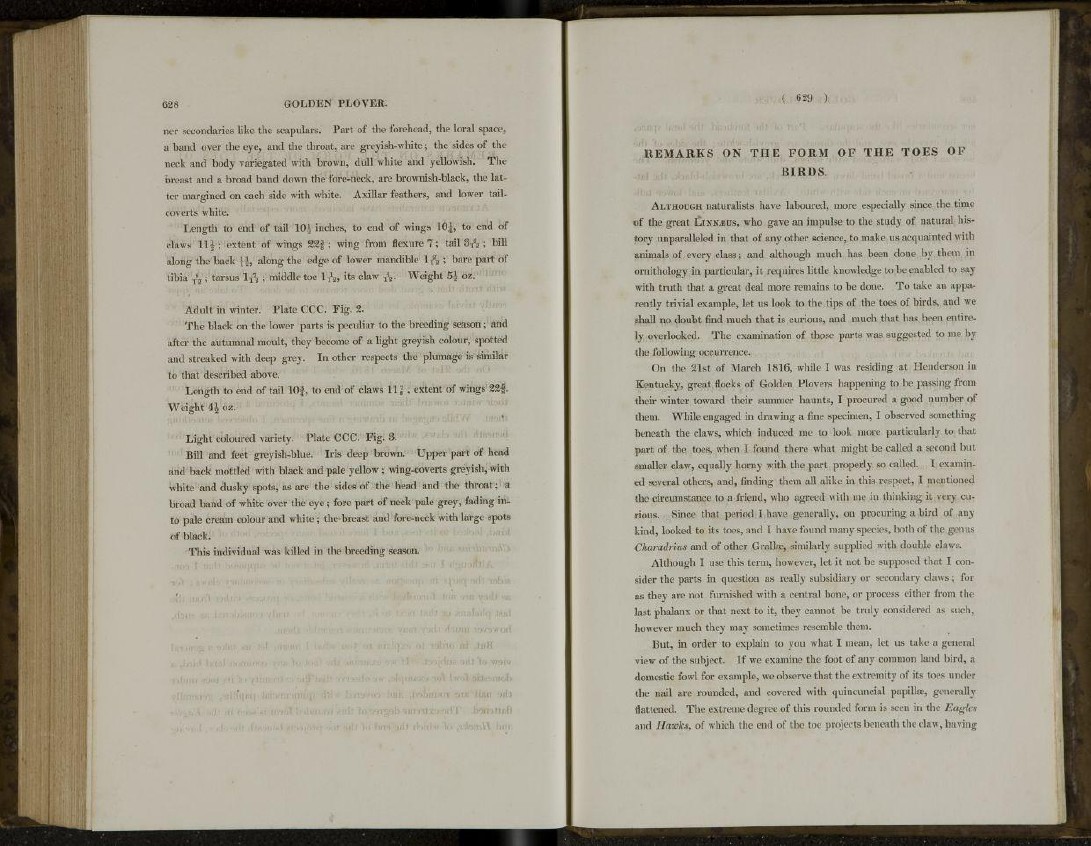
628 GOLDEN PLOVER.
ner secondaries like the scapulars. Part of the forehead, the loral space,
a band over the eye, and the throat, are greyish-white; the sides of the
neck and body variegated with brown, dull white and yellowish. The
breast and a broad band down the fore-neck, are brownish-black, the latter
margined on each side with white. Axillar feathers, and lower tailcoverts
white.
Length to end of tail 10inches, to end of wings 10£, to end of
claws 11 \ ; extent of wings 22§ ; wing from flexure 7; tail 3T
2
2 ; bill
along the back \l, along the edge of lower mandible 1 $ ; bare part of
tibia 82 ; tarsus 17
3 ; middle toe 3?ft> its claw 4
. Weight 5 | oz.
T
T
T
5 Adult in winter. Plate CCC. Fig. 2.
The black on the lower parts is peculiar to the breeding season; and
after the autumnal moult, they become of a light greyish colour, spotted
and streaked with deep grey. In other respects the plumage is similar
to that described above.
Length to end of tail lOf, to end of claws 11 \ , extent of wings 22§.
Weight 4 | oz.
\
Light coloured variety. Plate CCC. Fig. 3.
Bill and feet greyish-blue. Iris deep brown. Upper part of head
and back mottled with black and pale yellow ; wing-coverts greyish, with
white and dusky spots, as are the sides of the head and the throat; a
broad band of white over the eye; fore part of neck pale grey, fading into
pale cream colour and white ; the«breast and fore-neck with large spots
of black.
This individual was killed in the breeding season.
( 629 )
R E M A R K S O N T H E F O R M O F T H E T O E S OF
B I R D S .
ALTHOUGH naturalists have laboured, more especially since the time
of the great LINNJSUS, who gave an impulse to the study of natural history
unparalleled in that of any other science, to make us acquainted with
animals of every class; and although much has been done by them in
ornithology in particular, it requires little knowledge to be enabled to say
with truth that a great deal more remains to be done. To take an apparently
trivial example, let us look to the tips of the toes of birds, and we
shall no doubt find much that is curious, and much that has been entirely
overlooked. The examination of those parts was suggested to me by
the following occurrence.
On the 21st of March 1816, while I was residing at Henderson in
Kentucky, great flocks of Golden Plovers happening to be passing from
their winter toward their summer haunts, I procured a good number of
them. While engaged in drawing a fine specimen, I observed something
beneath the claws, which induced me to look more particularly to that
part of the toes, when I found there what might be called a second but
smaller claw, equally horny with the part properly so called. I examined
several others, and, finding them all alike in this respect, I mentioned
the circumstance to a friend, who agreed with me in thinking it very curious.
Since that period I have generally, on procuring a bird of any
kind, looked to its toes, and I have found many species, both of the genus
Charadrius and of other Gralhe, similarly supplied with double claws.
Although I use this term, however, let it not be supposed that I consider
the parts in question as really subsidiary or secondary claws; for
as they are not furnished with a central bone, or process either from the
last phalanx or that next to it, they cannot be truly considered as such,
however much they may sometimes resemble them.
But, in order to explain to you what I mean, let us take a general
view of the subject. If we examine the foot of any common land bird, a
domestic fowl for example, we observe that the extremity of its toes under
the nail are rounded, and covered with quincuncial papillae, generally
flattened. The extreme degree of this rounded form is seen in the Eagles
and Hawks, of which the end of the toe projects beneath the claw, having